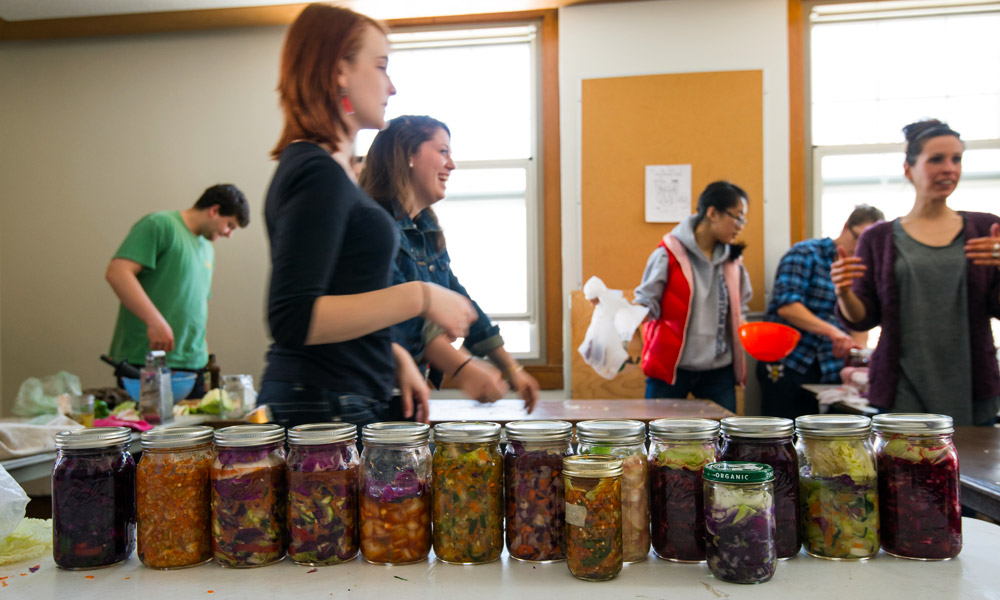When you head home for winter break, what are you hungry for? Dani Douglas ’17 poses the question to four of her classmates, and provides links to recipes for these home-made favorites.
Why we love home-cooked meals
It doesn’t always matter what’s being served, as long as it’s made at home.
That’s the view of Nora Rubel, an associate professor of religion and classics.
Rubel is an expert on American Judaism, as well as food and ethnicity. She’s the coeditor of the 2014 anthology Religion, Food, and Eating in North America (Columbia University Press), and is working on a book entitled Recipes for the Melting Pot: Reading The Settlement Cook Book.
“There’s a great deal of meaning in having someone make a special meal for you,” says Rubel, who recalls taking long drives home to New Jersey to find a pot of freshly made soup waiting for her.
Surprisingly, the quality of the cooking doesn’t always matter either.
“My paternal grandmother never learned how to cook, yet my father was accustomed to her food, and maybe even harbored some nostalgia for it,” she says. “Things didn’t taste right to him unless they were burnt or ill-prepared.”
Rubel notes that her mother used to make a “weird fruit compote” that included pineapple and curry powder—and she hated it. While feeling a sense of mortality one year, she decided to learn how to make the dish, since it reminded her of her mother.
“I created a narrative [surrounding] that recipe that made the dish important to me, whether I liked it or not,” she says. “Of course, when I found that the recipe was simply torn from a magazine, I gave up on the compote. But the point was made.”
—Peter Iglinski

Kiara Martinez ’19
Home: Boston, Massachusetts
Major: economics
As soon as Kiara Martinez ’19 steps out of the airport in her home city of Boston, she knows exactly where she’ll be headed: a local Colombian restaurant to pick up some lulo juice.
Lulo, a citrus similar to passion fruit, is native to Ecuador, where Martinez was born. She says that lulo juice reminds her of her childhood, when her family would pick lulo off a tree in her backyard.
“The fruit isn’t grown here, but there’s one place in Boston that makes [lulo juice]; so my mom will always take me there when I arrive,” she says.
When Martinez is away at school, there’s one thing in particular that she misses about her family’s home cooking, and that’s the seasoning. On Thanksgiving, her family’s turkey is sprinkled with Goya spices and always flavored with her dad’s favorite Chilean and Costa Rican sauces. Her mother’s cooking has become a fusion of Ecuadorian cuisine—natural, organic, and spiced—and Colombian cuisine, which she describes as “food fried twice.” Her favorite meal is her mother’s empanadas, deep fried crescents stuffed with beef, tomato, and cilantro.
“It doesn’t even matter what we’re eating,” she says. “It’s honestly the seasoning aspect that I miss most.”

Jenny Jun ’18
Home: Fullerton, California
Major: health policy
When Jenny Jun ’18 returns to Southern California for the holidays, she’s doesn’t expect to be eating at restaurants too often. Jun says her mother doesn’t like eating out, and she’s a very talented cook.
Jun’s mother and father both emigrated to the United States from South Korea. She says her family often experiments with American dishes, but they tend to eat a lot of Korean food.
“It’s really nice to just go home and eat the meals that I grew up eating,” Jun says.
The dish she looks forward to the most while she’s home is kimchi jigae, a Korean stew that her mother prepares from scratch. Kimchi is fermented cabbage. Preparing it can be a time-consuming process that involves finding the perfect blend of salt and spices.
“I’ve watched my mom make the kimchi since I was young,” Jun says. “Now every time I go home, I actually try to learn how to make it myself.”

Shreya Patel ’17
Home: Jonesboro, Alabama
Major: general engineering
After a long day of travel home to Alabama, Shreya Patel ’17 knows she’ll be heading straight from the airport to indulge in Chick-fil-A. Going to school in the northeast, she finds that she really misses southern-style cooking.
“My favorite home-cooked meal is definitely fried chicken, mashed potatoes and collard greens,” she says.
Patel says being home allows her to have a more balanced diet, and, free from her busy school schedule, she enjoys being able to eat dinner at an earlier hour.
Although her family doesn’t often cook, when they do, her aunt usually takes the lead, alternating between Indian, Mexican, and American dishes.
“When I’m at school, I really miss my aunt’s homemade tacos,” Patel says. “They’re hard-shelled, and packed with beans, lettuce, tomatoes, cheese, sour cream, fried tortilla, and taco sauce.”

Chris Horgan ’17
Home: Medina, New York
Majors: political science and creative writing
Although the place Chris Horgan ’17 calls home is only an hour’s drive from Rochester, he usually only sees his family during breaks and holidays.
But each time he makes the trip from the University to Medina, located just outside of Buffalo, he knows that a warm dish of chicken cacciatore will be waiting for him.
“I just feel like the food from home has more soul and love,” Horgan says. Smiling, he adds, “Maybe that’s not fair to say—they put a lot of love in the food here, but it’s just the variation at home that I miss.”
Even though he knows that his first meal home will be Italian, both his parents are actually of Irish descent. His favorite meal, without a doubt, is corn beef and cabbage with potatoes.
“The Irish part of our meals is that they always seem to have potatoes involved,” Horgan says. “My mom is a wonderful cook. You’re making me miss her food as we speak.”

Home cooked—and home grown
By Lindsey Valich
“One of the main values of growing and cooking your own food is that this gives you control and awareness about where your food is coming from,” says Leila Nadir, a lecturer in sustainability and environmental humanities at Rochester. “The more we can take control over what we put in our bodies, the more awareness we can have of our own health.”
According to Nadir, increased consumption of processed foods and mass-produced meals not only means people often don’t know what they’re eating, but it also denotes a break from basic, do-it-yourself food preparation skills such as preserving, pickling, and slow cooking.
She’s partnered with Cary Peppermint, an associate professor of art and art history at Rochester, to help people rediscover endangered food and environmental practices. Their project, part of the ongoing initiative EcoArtTech, is designed to eliminate what they deem “industrial amnesia”—a neglect of do-it-yourself practices of growing and preparing food, caused by industrialization.
The project includes workshops on the process of fermenting, such as turning cabbage into sauerkraut; communal meal preparation and dining experiences; and work with SeedFolk City Farm, which invites youths in the city of Rochester to practice urban farming at sites throughout the city.
Nadir further lauds the environmental benefits of growing your own food, buying locally sourced ingredients, and eating fruits and vegetables that are in season. Such practices help reduce resources used to package and transport food from distant locations and decrease the use of pesticides.
In addition to the benefits of home-cooked meals, Nadir says many people believe that the emotions of the person cooking your food are manifested in the actual meal.
“When food is made by a machine, you possibly might not have the same experience as you would if someone who loves you creates your food,” Nadir says. “Our culture has a saying that food tastes better when it’s made with love. We laugh about it and joke about it, but maybe it’s more real than we’d like to admit.”



